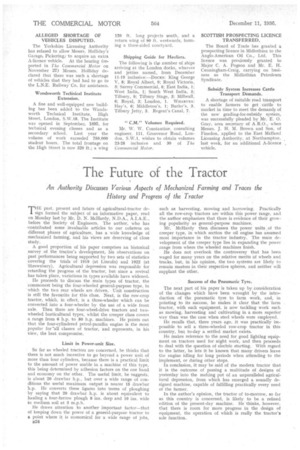The Future of the Tractor
Page 42

If you've noticed an error in this article please click here to report it so we can fix it.
An Authority Discusses Various Aspects of Mechanized Farming and Traces the History and Progress of the Tractor THE past, present and future of agricultural-tractor design formed the subject of an informative paper, read on Monday last by Mr. D. N. McHardy, N.D.A., A.I.A.E., before the Society of Engineers. The author, who has 'contributed some invaluable articles to our columns on different phases of agriculture, has a wide knowledge of mechanized farming, and his views are deserving of close study.
A good proportion of his paper comprises an historical .survey of the tractor's development, his observations on past performances being supported by two sets of statistics covering the trials of 1919 (at Lincoln) and 1922 (at Shrewsbury). Agricultural depression was responsible for retarding the progress of the tractor, but since a revival has taken place, variations in types available have widened.
He proceeds to discuss the main types of tractor, the commonest being the four-wheeled general-purpose type, in -which the two rear wheels are driven. Unit construction is still the favourite for -this class. Next, is the row-crop tractor, which, in effect, is a three-wheeler which can be converted into a four-wheeler by the use of a wide front axle. Then there are four-wheel-drive tractors and twowheeled horticultural types, -whilst the creeper class covers a range from 6 h.p. to 80 h.p. machines. He points out that the four-cylindered petrol-paraffin engine is the most ,popular forall classes of tractor, and represents, in his view, the best compromise.
Limit in Power-unit Size.
So far as wheeled tractors are concerned, he thinks that -there is not much incentive to go beyond a power unit of more than four cylinders, because there is a practical limit to the amount of power usable in a machine of this type, this being determined by adhesion factors on the one hand and economy on the' other. The useful limit, he suggests,
• is about 20 drawbar h.p., but over a wide range of conditions the useful maximum output is nearer 15 drawbar h.p. He converts these figures into terms of ploughing • by saying that 20 drawbar h.p. is about equivalent to hauling a four-furrow plough 8 ins, deep and 10 ins, wide in medium soil at 3 m.p.h.
He draws attention to another important factor—that of keeping down the power of a general-purpose tractor to a point where it is economical for a wide range of jobs, B24 such as harvesting, mowing and harrowing. Practically all the row-crop tractors are within this power range, and the author emphasizes that there is evidence of their growing popularity as general-purpose machines,
Mr. Met-tardy then discusses the power units ,of the creeper type, in which section the oil engine has assumed most importance in the tractor industry. The main development of the creeper type lies in expanding the power range from where the wheeled machines finish.
He does not overlook the controversy that has been waged for many years on the relative merits of wheels and tracks, but, in his opinion, the two systems are likely to remain masters in their respective spheres, and neither will supplant the other.
Success of the Pneumatic Tyre.
The next part of his paper is taken up by consideration of the changes which have been wrought by the introduction of the pneumatic tyre to farm work, and, in pointing to its success, he makes it clear that the 'farm tractor, with such equipment, is now tackling work such as mowing, harvesting and cultivating in a more superior way than was the case when steel wheels were employed.
He recalls that, three years ago, it was practically impossible to sell a three-wheeled row-crop tractor in this country, but to-day a settled market exists.
He makes reference to the need for good lighting equipment on tractors used for night work, and then proceeds to deal with the question of electric starting. With regard to the latter, he lets it be known that many drivers leave the engine idling for long periods when attending to the implement, or during other stops.
In conclusion, it may be said of the modern tractor that it is the outcome of passing a multitude of designs of yesterday into the melting pot of an unparalleled agricultural depression, from which has emerged a soundly designed machine, capable of fulfilling practically every need of the farmer.
In the author's opinion, the tractor of to-morrow, so far as this country is concerned, is likely to be a refined edition of the present-day machine. He thinks, however, that there is room for more progress in the design of equipment, the operation of which is really the tractor's sole function.




































































































